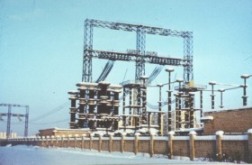Categories: Interesting Facts, Controversial issues
Number of views: 36356
Comments on the article: 5
The future for DC power systems?
 In the beginning of the twentieth century, fierce debates between specialists over the advantages and disadvantages of using direct and alternating current circuits for power supply. It so happened that preference was given to three-phase AC circuits. Industrialists, calculating the volume of capital costs for the creation of power supply systems, have chosen, it would seem, the most optimal option.
In the beginning of the twentieth century, fierce debates between specialists over the advantages and disadvantages of using direct and alternating current circuits for power supply. It so happened that preference was given to three-phase AC circuits. Industrialists, calculating the volume of capital costs for the creation of power supply systems, have chosen, it would seem, the most optimal option.
The decisive role in the ubiquity of three-phase AC networks was played by the simplicity of obtaining torque with a minimum number of phases. Against direct current, such arguments were put forward as the high cost and low reliability of engines, the complexity of energy conversion. But that was then. What now? The practical experience gained over many years of the development of the electric power industry gives, in my opinion, devastating results.
The first one. From the course theoretical foundations of electrical engineering It is known that in order to transfer maximum power to the load in alternating current circuits, the condition of equal source resistance to line resistance and load resistance must be fulfilled. It follows that the theoretically achievable efficiency for AC circuits is 33%.
Practical power schemes to reduce energy transportation losses involve a certain number of voltage conversions. At least it is not less than five transformations, each of which uses its own transformer. If we take the efficiency of each optimally loaded transformer equal to 0.9, then the total transformation efficiency will be 0.9 0.9 0.9 0.9 0.9 = 0.59049, and the power supply efficiency - 0.33 0.59049 = 0. 1,948,617.
 Given that the power of the transformers is selected taking into account the morning and evening maximums of the loads, their real average weighted efficiency of the transformers is lower than 0.9, therefore, the real power supply efficiency is lower than 0.195. And this is without taking into account leakage currents, reactive currentsharmonics and other delights.
Given that the power of the transformers is selected taking into account the morning and evening maximums of the loads, their real average weighted efficiency of the transformers is lower than 0.9, therefore, the real power supply efficiency is lower than 0.195. And this is without taking into account leakage currents, reactive currentsharmonics and other delights.
Studies conducted by K.V. Yalovega at metallurgical plants have shown that on the shaft of the working machine we have in the form of useful energy only about 2.4% of the energy supplied to the shaft of the generator at the power plant. It is no coincidence that the efficiency of domestic wind turbines when working on a single power grid barely reaches 11%.
The second one. The same N.V. Yalovega suggested installing orthogonal combined windings in three-phase asynchronous AC motors, in which the angle of shift between the phases has two values - 120 and 90 degrees. He proved that if a four-phase power supply were adopted, then the generation of electricity could be reduced by three to four times with the same useful robot.
The widespread use of induction motors with orthogonal windings would reduce the generation of electricity by an average of three times. This is due to the fact that about 70% of the electricity is consumed precisely by induction motors. Thus, the choice of a three-phase current system was, to put it mildly, not optimal.
 The third. In Soviet times, a reversible DC power transmission system was built, connecting the Volga hydroelectric power station and the Mikhailovsky substation (Donbass) with a voltage of 750 kV. The practice of operating the system has shown its high efficiency. It has been proven that using direct current to transmit electricity over long distances has clear advantages over an alternating current system. Efficiency in direct current circuits can reach 90% or more. It is not in vain that the energy companies of Japan and the United States have repeatedly made attempts to purchase equipment for DC substations.
The third. In Soviet times, a reversible DC power transmission system was built, connecting the Volga hydroelectric power station and the Mikhailovsky substation (Donbass) with a voltage of 750 kV. The practice of operating the system has shown its high efficiency. It has been proven that using direct current to transmit electricity over long distances has clear advantages over an alternating current system. Efficiency in direct current circuits can reach 90% or more. It is not in vain that the energy companies of Japan and the United States have repeatedly made attempts to purchase equipment for DC substations.
Thus, we all became hostages of the current situation in the energy sector. We are forced to pay all the costs of transportation and distribution of energy with a centralized power supply. The situation is different when creating autonomous power supply systems. The consumer himself is free to choose what is best for him, alternating or direct current. The only limitation is imposed by final loads that cannot work in DC circuits. But this is not a problem today.
For almost a hundred years, the conversion technology has undergone significant changes, and if 25 years ago, inverters and semiconductor converters were the prerogative of the defense industry, today they are widely used in industry and everyday life. Many household appliances have switching power supplies that can operate in both AC and DC circuits.
Therefore, when creating autonomous sources of electricity, it is better to give preference to direct current. However, in this case, not without problems.
If we draw a complete scheme of autonomous power supply using an inverter, it becomes clear that at least three pn junctions will be sequentially connected in the circuit between the source and the consumer. At each transition, the voltage drop will be about 1.5 V, the total voltage drop will be at least 4.5 V. Plus the remaining losses.
Therefore, when creating autonomous energy sources using inverters, the use of low-voltage generators 14, 28 V is impractical. Preference should be given to generators with an output voltage of 230 V, which is standard for household networks. And if it is possible to transfer the equipment power to direct current, it is better not to neglect it.
We came to this conclusion while developing autonomous sources of power supply. It would be interesting to learn other opinions. It is possible that they will radically change not only our views on the existing problem.
YES. Duyunov. A.B. Pajankov. S.I. Levachkov
See also at bgv.electricianexp.com
:
